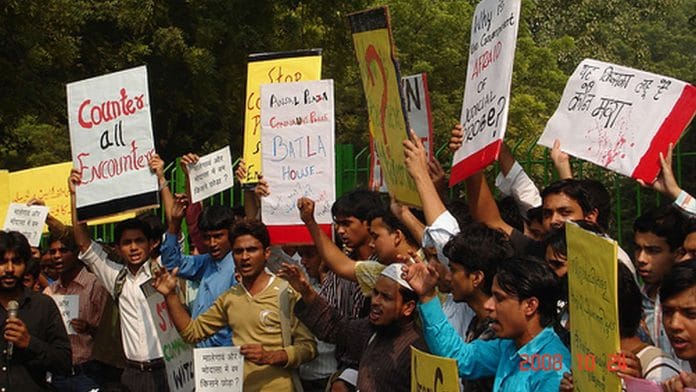New Delhi: Eleven years ago, on 19 September, a Delhi Police Special Cell team carried out an encounter in Jamia Nagar’s Batla House, where two suspected Indian Mujahideen (IM) terrorists were killed, as was inspector Mohan Chand Sharma.
The operation was originally meant to just gather intelligence about the residents of Batla House and was led by inspector Sharma, an encounter specialist. However, it escalated into a shootout after the suspects allegedly began firing at the police. A 20-minute encounter followed, during which Sharma was fatally injured.
The suspected IM operatives were said to have been involved in the serial bomb blasts that took place in Delhi six days before the encounter.
Of the five men residing in the apartment in Batla House, Mohammed Sajid and Atif Amin were killed on the spot, Junaid and Shahzad Ahmad fled but were caught years later, while Mohammad Saif surrendered to the police. Junaid was, in fact, caught last year.
The encounter rocked the country and faced massive public scrutiny, with many claiming that it was staged. It was later turned into a Bollywood film called Batla House, starring John Abraham.
The serial blasts
Six days before the encounter, on 13 September 2008, a series of five low-intensity bomb blasts exploded in Connaught Place, Greater Kailash and Karol Bagh, killing 30 people and injuring over 90.
Ten minutes after the first blast, an email was sent to the media in which the IM claimed responsibility for the attack. The email claimed the blasts were carried out as revenge for the demolition of the Babri Masjid in 1992.
Convictions and arrests
Shahzad Ahmed, who fled from the encounter, was caught in 2010 and charged with the murder of inspector Sharma. The Delhi High Court convicted Shahzad on the count of murder and sentenced him to life imprisonment.
The Jamia Teachers’ Solidarity Association (JTSA) released a 25-page booklet with its own independent findings on the Batla House encounter and questioned the conviction of Shahzad.
Junaid, the other resident of Batla House who had escaped the encounter, was arrested in 2018 from Uttarakhand. According to the police, he had fled to Nepal.
Also read: Rahul’s temple visits, Sonia’s lament show Cong is resetting secular politics, moving to centre
The fallout
The Batla House encounter was almost immediately mired in controversy, with many civil servants, human rights activists and journalists questioning the veracity of the encounter.
The day after the incident, widespread protests were organised against the encounter, with many claiming that it was staged. A fact-finding team led by Janhastakshep and the People’s Union for Democratic Rights (PUDR), demanded a judicial inquiry into the encounter.
In a press conference, activist and lawyer Prashant Bhushan raised questions about the incident. He asked whether the police knew that the residents of Batla House were actually affiliated with the IM. If they were, Bhushan said it was inconceivable that the police were not wearing bullet-proof jackets. If they weren’t, it made no sense that a few hours after the encounter, the police claimed to have apprehended the mastermind of the serial blasts.
There were also claims that the police was arbitrarily arresting Muslim youth from Jamia Nagar. Neyaz Farooque, a journalist with the Hindustan Times, documented this in his book An Ordinary Man’s Guide to Radicalism: Growing up Muslim.
But while there were a lot of allegations about a staged encounter, no hard evidence was ever put before a court to back up these claims.
Long investigation preceded encounter
There were also reports that inspector Sharma had conducted a long investigation preceding the encounter. After the bomb blasts in Ahmedabad in 2005, an organised crime figure named Afzal Usmani was arrested, and directed investigators towards the “mastermind” of IM, Bashir, who he said was residing in Jamia Nagar.
A second important lead found by Gujarat Police, who traced a phone call from a terror suspect to the apartment in Jamia Nagar. These two leads were put together, and inspector Sharma was then asked to trace these men.
On why Sharma wasn’t wearing a bulletproof vest, it was reported that he had removed it due to the summer heat because he did not think the men would be armed.
Also read: Hamara desh badal gaya hai
NHRC report
In 2009, the Delhi High Court ordered the National Human Rights Commission to conduct an investigation into the authenticity of the encounter, after a plea was filed by the PUDR. The NHRC eventually gave a clean chit to the Delhi Police and Delhi High Court accepted this decision, rejecting any further demands for a judicial probe.
However, the report by the NHRC was dated two days before it was even asked to investigate the matter by the high court. This implied that it had not conducted an investigation of its own, and instead, relied only on police reports.
The post-mortem report of the victims of the shootout also raised several flags, and was, oddly, not included in the NHRC report.






